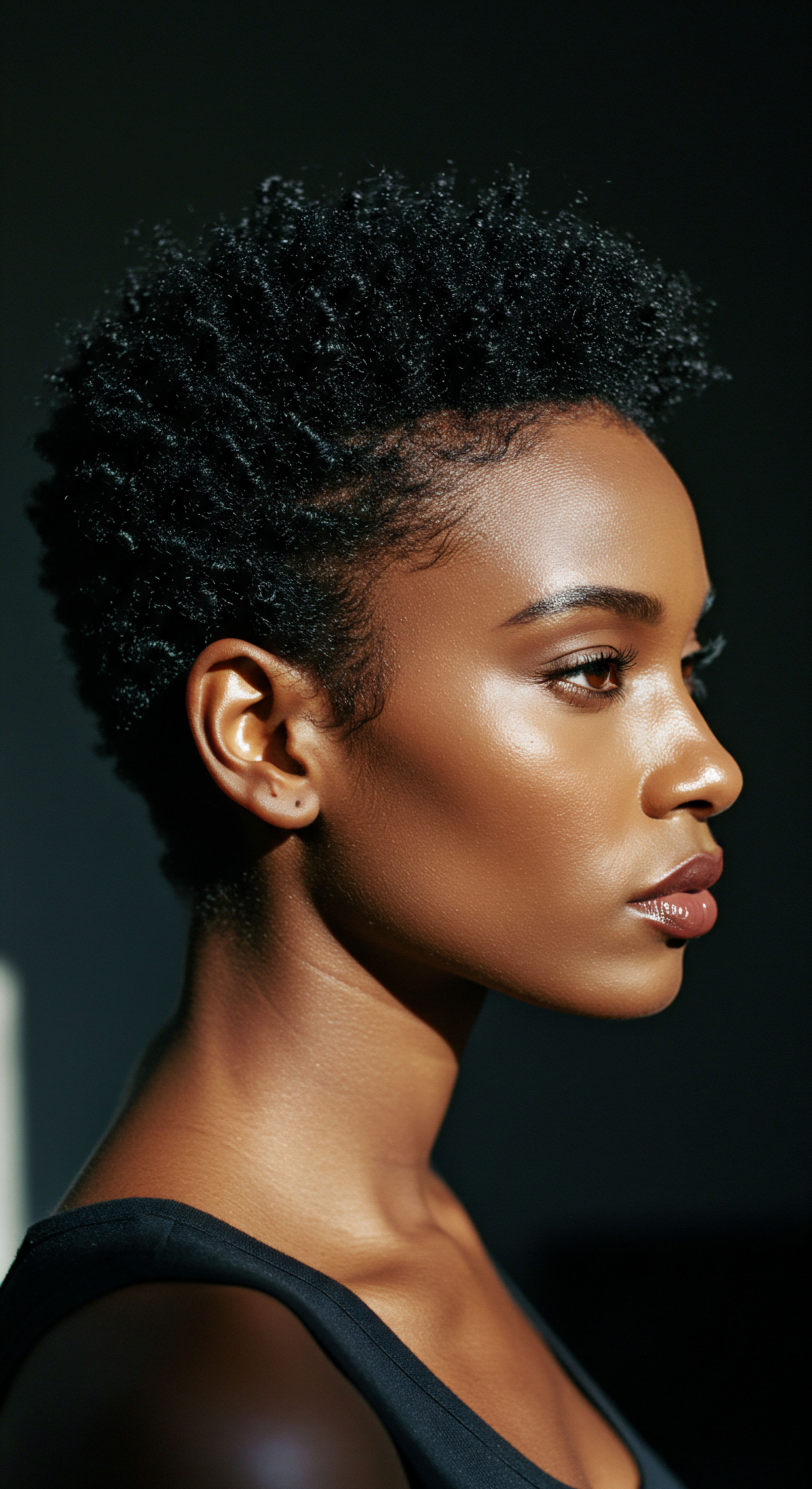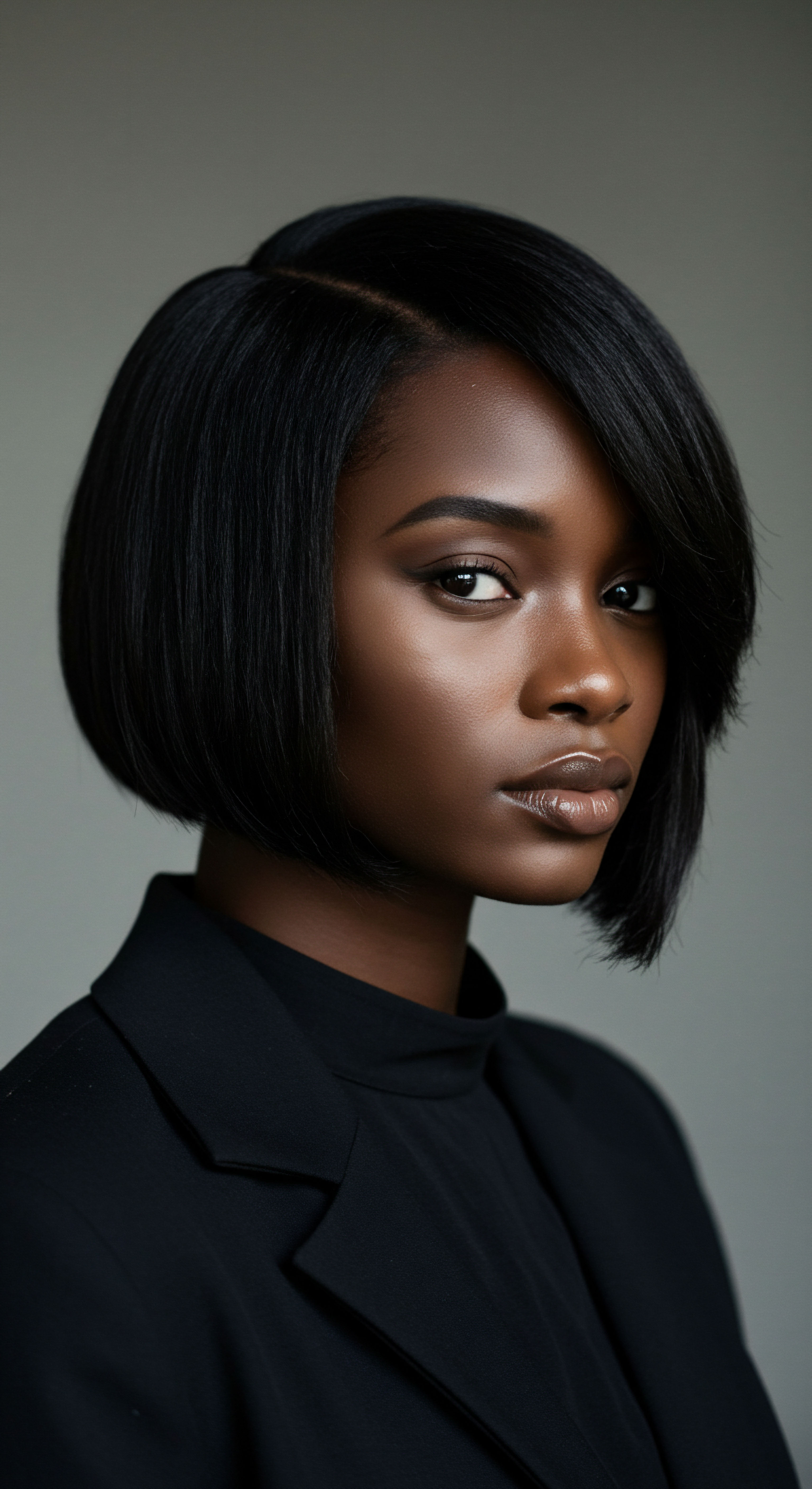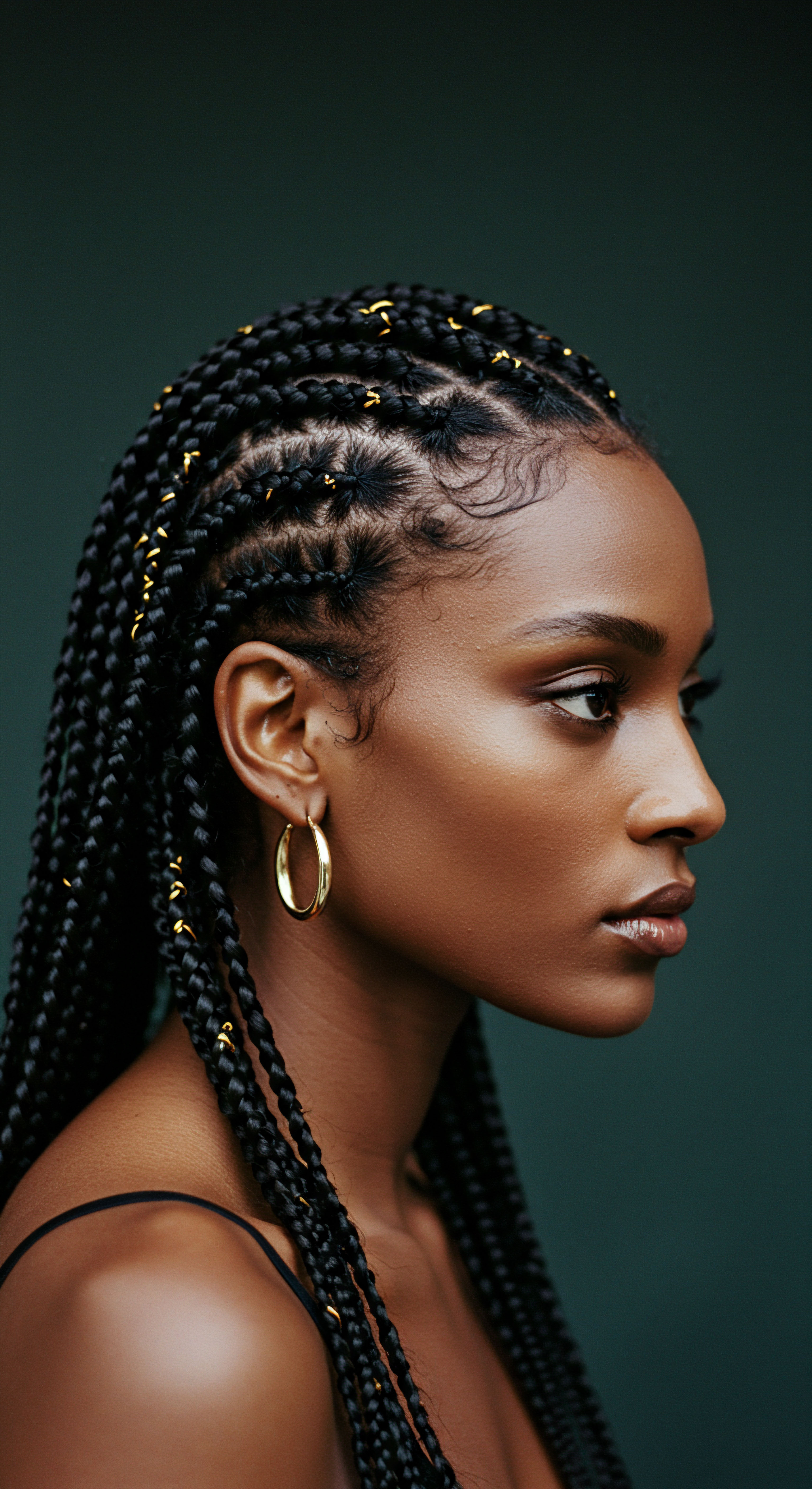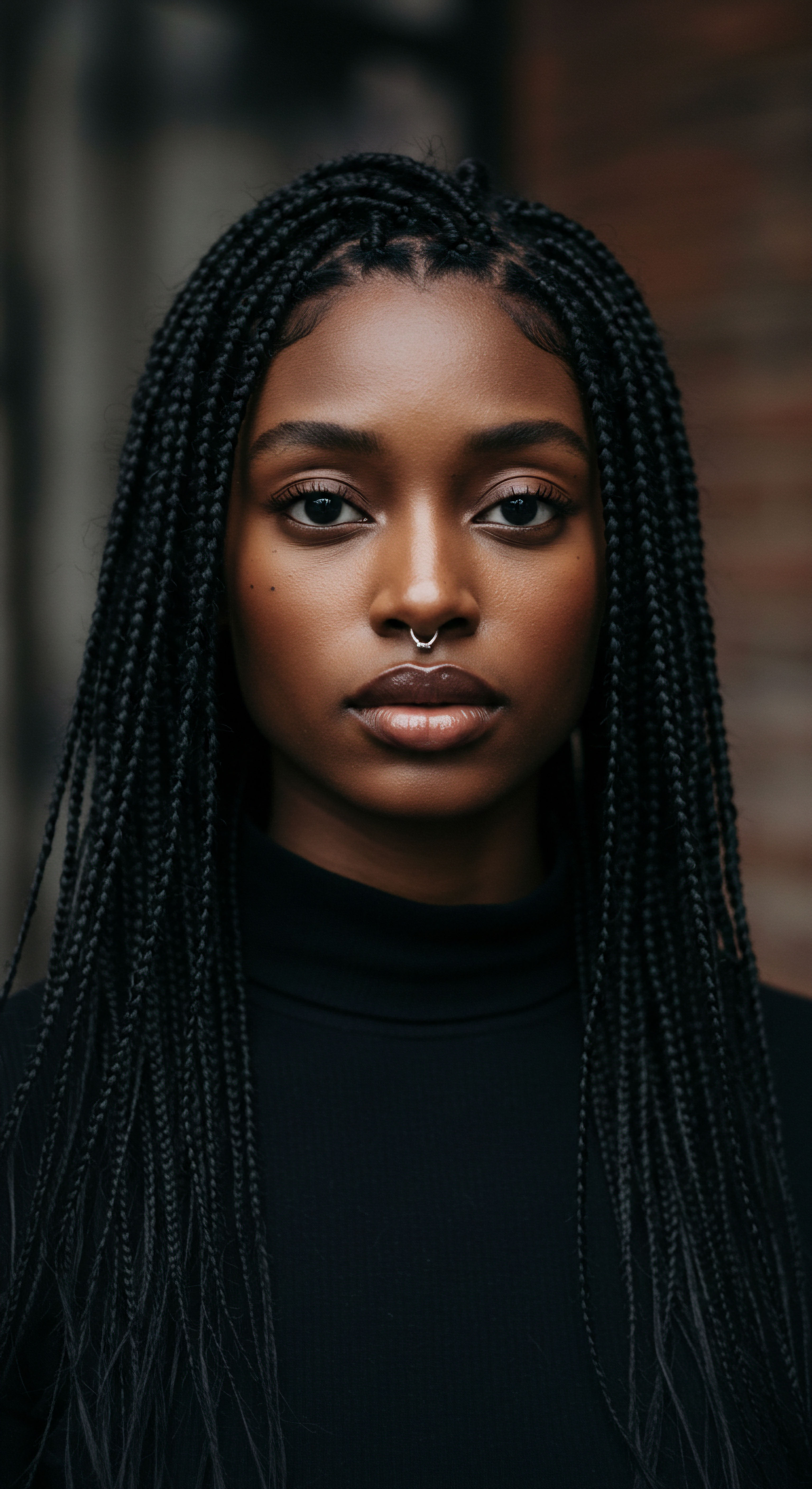
Roots
The very strands that crown us hold whispers of ancestry, tales of resilience, and a silent language of their own. Within the intricate architecture of coily textures lies a profound dialogue with the world around them, a conversation largely dictated by a characteristic often overlooked ❉ porosity. To truly honor and tend to these magnificent coils, one must first listen closely to what the hair itself reveals about its thirst, its protective layers, and its willingness to receive. This quiet observation, this deep listening, forms the bedrock of understanding how a seemingly simple act, like choosing an oil, transforms into a deliberate gesture of care, deeply connected to the hair’s fundamental nature.

What is Hair Porosity Unveiled?
At its core, hair porosity refers to the cuticle’s capacity to absorb and retain moisture. The cuticle, the outermost layer of each hair strand, resembles tiny overlapping scales, much like shingles on a roof. The way these scales lie determines how open or closed the hair shaft is. A highly porous strand has cuticles that are raised or widely spaced, allowing moisture to enter and exit with ease.
Conversely, low porosity hair possesses tightly bound, flattened cuticles, creating a formidable barrier against water and products alike. Somewhere in the middle resides normal porosity, where the cuticles are neither too open nor too closed, maintaining a balanced exchange with the environment.
Hair porosity describes the cuticle’s ability to absorb and hold moisture, dictating how strands interact with hydration.
Consider the subtle variations across coily textures, where the very curl pattern can influence how the cuticle layers present themselves. The twists and turns inherent to coily hair create points of vulnerability where the cuticle may naturally lift more readily. This physical reality underscores why a nuanced comprehension of porosity is not merely academic for those with coily strands, but a practical imperative for their well-being.

Coily Hair Architecture and Porosity’s Mark
The distinct helical shape of coily hair strands sets them apart from straighter counterparts, influencing not only their appearance but also their inherent properties. Each twist and turn represents a potential stress point, areas where the cuticle may be more prone to lifting, especially with external manipulation. This structural characteristic means that even within a single head of coily hair, porosity can vary from one section to another, or even along the length of a single strand. The ends, for instance, often exhibit higher porosity due to cumulative damage from styling, environmental exposure, and daily wear.
Understanding this variability is a cornerstone of tailored hair care. A uniform approach, treating all hair as if it behaves identically, often leads to frustration and suboptimal results. Instead, a more discerning eye recognizes the unique requirements of different hair sections, allowing for a personalized application of oils and other treatments that truly meet the hair where it is.

The Cuticle’s Silent Dialogue
The cuticle, though microscopic, orchestrates a continuous silent dialogue with its surroundings. When exposed to water, the cuticles of highly porous hair may swell rapidly, absorbing a great deal of moisture. However, this ease of entry is mirrored by an equal ease of escape, leading to quick drying and a propensity for dehydration.
Low porosity hair, on the other hand, resists water’s initial entry, causing it to bead on the surface. Once moisture does penetrate, however, it tends to stay, making this hair type prone to product buildup if heavy formulations are used.
This interaction dictates the very first step in selecting an oil ❉ will it assist in opening the cuticle just enough, or will it create an impermeable seal? The answer lies in the oil’s molecular weight and its chemical composition, factors that directly influence its ability to interact with the cuticle’s surface.
- Low Porosity hair ❉ Tightly packed cuticles resist moisture entry but retain it once absorbed.
- High Porosity hair ❉ Raised cuticles absorb moisture readily but lose it quickly.
- Normal Porosity hair ❉ Balanced cuticles allow for steady moisture exchange.

How Porosity is Assessed?
Determining one’s hair porosity does not require complex laboratory equipment; several simple, observational methods can offer telling insights. The most common involves placing a clean, product-free strand of hair into a glass of water. If the strand floats, it often indicates low porosity.
If it sinks immediately, high porosity is suggested. A strand that drifts somewhere in the middle, slowly sinking, typically points to normal porosity.
Beyond the water test, observing how your hair reacts to products offers another layer of discernment. Does conditioner sit on your hair for a while before absorbing? This could suggest low porosity. Does your hair dry very quickly after washing, or does it feel rough and brittle even after conditioning?
These are common signs of high porosity. These tactile and visual cues, combined with the water test, paint a more complete picture of your hair’s unique needs.
| Porosity Type Low Porosity |
| Cuticle State Tightly closed, flat |
| Moisture Interaction Resists water, prone to product buildup, takes time to dry |
| Porosity Type Normal Porosity |
| Cuticle State Slightly raised, balanced |
| Moisture Interaction Absorbs and retains moisture well, healthy appearance |
| Porosity Type High Porosity |
| Cuticle State Raised, open, damaged |
| Moisture Interaction Absorbs water quickly, dries fast, prone to frizz and breakage |
| Porosity Type Understanding these characteristics guides personalized care decisions. |

Ritual
Having acquainted ourselves with the foundational principles of hair porosity, our contemplation now turns to the practical wisdom that flows from this knowledge. The daily and periodic rituals of hair care, particularly the selection and application of oils, become profoundly more effective when guided by an understanding of the hair’s intrinsic thirst. This section seeks to illuminate the artful choices that transform a routine into a purposeful ceremony, where each drop of oil is chosen with a gentle knowing, tailored to the unique responsiveness of coily strands. It is a journey from abstract science to applied tenderness, where techniques and methods are explored with thoughtful guidance, ensuring that our hair receives precisely what it asks for.

Oil Categories for Coily Hair
Not all oils are created equal, particularly when considering their interaction with varying hair porosities. Broadly, oils can be categorized by their molecular size and their primary function ❉ those that primarily penetrate the hair shaft and those that primarily seal the cuticle. Penetrating oils, often characterized by smaller molecular structures, can slip beneath the cuticle layers to nourish the hair from within. Sealing oils, with larger molecules, tend to rest on the hair’s surface, forming a protective barrier that locks in moisture and shields the strand from environmental aggressors.
The choice between these two categories, or a blend of both, becomes a deliberate act, a mindful response to the hair’s porosity. For some, a lighter touch is needed to avoid overburdening the strands, while for others, a more robust shield is essential to guard against moisture loss.

Selecting Oils for Low Porosity Coils
Low porosity hair, with its tightly bound cuticles, presents a unique challenge ❉ inviting moisture in without creating a heavy, greasy film. The key here lies in selecting oils that are light in texture and possess smaller molecular weights, allowing them to gently permeate the resistant cuticle. Applying heavier oils to low porosity hair often results in product sitting on the surface, leading to a dull appearance, lack of movement, and potential buildup that can hinder true hydration.
Consider oils like Jojoba Oil, which closely mimics the hair’s natural sebum, or Sweet Almond Oil, known for its lightness. Grapeseed Oil and Argan Oil are also excellent choices, as they provide conditioning without imparting excessive weight. These oils can be warmed slightly before application to help them absorb more readily, as gentle heat can encourage the cuticles to lift just enough to receive the oil’s benefits. A less-is-more approach is particularly pertinent here; a small amount, evenly distributed, often yields the best results.

Oil Choices for High Porosity Coils
High porosity hair, characterized by its open, often raised cuticles, is prone to rapid moisture loss. The objective for this hair type is to seal the cuticle effectively, preventing precious hydration from escaping. This calls for oils with larger molecules that can create a substantial protective barrier on the hair’s surface. These heavier oils help to smooth down the lifted cuticles, reducing frizz and enhancing shine, while also providing a lasting seal.
Castor Oil, with its viscous consistency, is a popular choice for high porosity hair, known for its ability to coat the strands. Olive Oil and Avocado Oil are also highly beneficial, offering rich emollients that help to fortify the hair’s outer layer. These oils can be applied after a water-based moisturizer or leave-in conditioner, serving as the final step in the moisture sealing process. Their robust nature provides the necessary protection against environmental humidity, which can otherwise cause highly porous hair to swell and frizz.
For low porosity, lighter oils prevent buildup, while high porosity benefits from heavier oils that seal the cuticle.
The sequence of product application matters significantly. For high porosity hair, applying a penetrating oil before a sealing oil can offer a dual benefit ❉ internal nourishment followed by external protection. This layered approach helps to address both the hair’s thirst and its need for a sustained moisture barrier.

Balanced Approaches for Normal Porosity Coils
Normal porosity hair, residing in that fortunate middle ground, offers a greater degree of flexibility in oil selection. Its balanced cuticles allow for efficient absorption and retention of moisture, meaning it generally responds well to a wide range of oils. The goal here is to maintain this equilibrium, providing nourishment and protection without overdoing it.
A blend of penetrating and sealing oils often works beautifully for normal porosity. Lighter oils can be used for daily moisture, while slightly heavier options can be incorporated for deeper conditioning treatments or when extra protection is desired. Coconut Oil, often a point of discussion in hair care circles due to its unique ability to penetrate the hair shaft (a quality less common among other oils), can be a good option for normal porosity hair when used judiciously. Its medium weight and conditioning properties make it versatile.
The key with normal porosity is attentiveness to the hair’s current state and environmental factors. On humid days, a slightly more sealing oil might be beneficial, while in drier conditions, a more penetrating oil could be favored. This adaptability allows for a truly responsive care ritual.

Applying Oils with Intention
The method of oil application is as significant as the oil chosen. For all porosity types, applying oil to damp, freshly moisturized hair is often most effective. Water acts as the primary hydrator, and the oil then serves to seal that hydration in.
For low porosity hair, a light misting of water before oil application can help to slightly raise the cuticles, making them more receptive. For high porosity, a more generous application after a leave-in conditioner helps to truly lock in the moisture.
Distribution is also key. Rather than globbing oil onto the hair, warming a small amount between the palms and gently smoothing it down the hair shaft, focusing on the mid-lengths and ends, ensures even coverage without oversaturation. For scalp health, a gentle massage with a few drops of a suitable oil can stimulate circulation and provide nourishment to the hair follicles. This mindful application transforms a simple step into a meaningful act of care.
- Warm oils gently to aid absorption, especially for low porosity hair.
- Apply oils to damp hair to seal in existing moisture.
- Focus application on mid-lengths and ends to avoid weighing down roots.

Relay
Having navigated the foundational science and practical rituals of oil selection based on hair porosity, our contemplation deepens, moving beyond the immediate surface to the intricate interplay of factors that shape the very life of coily strands. How do environmental subtleties, the microscopic world of the scalp, and the enduring wisdom of cultural heritage truly inform our oil choices, transcending a simple porosity chart? This section invites a profound exploration, where scientific inquiry converges with cultural intelligence, unveiling a multi-dimensional perspective on hair care that honors both the biological blueprint and the lived experience. It is here that we consider the less apparent complexities, drawing upon relevant research and historical practices to construct a truly holistic understanding.

Beyond Porosity Environmental Influences
While porosity provides a critical lens through which to view oil selection, the environment in which our coily hair exists exerts an undeniable influence. Humidity, for instance, can significantly alter the hair’s behavior. In highly humid climates, high porosity hair may absorb excessive moisture from the air, leading to swelling and frizz, even after oil application. In such conditions, a robust sealing oil becomes even more critical to maintain structural integrity.
Conversely, in arid environments, all hair types, but particularly high porosity, face a constant battle against moisture evaporation. Here, the consistent use of humectants followed by a sealing oil becomes a protective shield.
Air quality also plays a role. Exposure to pollutants can deposit particulate matter on the hair and scalp, potentially disrupting the cuticle and affecting its porosity over time. Oils can act as a barrier against some of these environmental aggressors, but their effectiveness depends on their composition and how well they are layered with other protective products.
The sun’s ultraviolet rays also degrade hair proteins and lipids, increasing porosity and making strands more vulnerable. Oils with natural UV-filtering properties, such as Red Raspberry Seed Oil or Carrot Seed Oil, can offer a subtle layer of defense, though they should not replace dedicated sun protection.

The Scalp Microbiome and Oil Interaction
The scalp is a dynamic ecosystem, home to a complex community of microorganisms known as the scalp microbiome. This intricate balance of bacteria, fungi, and viruses plays a significant role in overall hair health, influencing everything from inflammation to nutrient delivery to the hair follicle. The oils we apply to our hair and scalp do not exist in isolation; they interact directly with this microbial landscape.
Certain oils possess antimicrobial or anti-inflammatory properties that can support a healthy scalp microbiome. For example, Tea Tree Oil (when properly diluted) or Neem Oil are often used for their purported ability to address scalp imbalances. However, heavy, non-comedogenic oils applied too frequently can potentially disrupt the delicate balance, leading to an overgrowth of certain microorganisms or clogging of follicles, particularly for those prone to scalp conditions. The impact of oils on the scalp microbiome is an emerging area of study, with research suggesting that the lipid environment created by sebum and applied oils directly influences microbial diversity and function.
For instance, a 2017 study published in the journal Scientific Reports identified distinct microbial communities associated with different scalp conditions, noting that lipid metabolism plays a role in shaping these communities. While not directly about oil selection for porosity, this research underscores the broader interaction between external lipids (oils) and the scalp’s microbial ecosystem, suggesting that oil choices should consider not just the hair strand but also the living scalp environment.
Oil choices for coily hair extend beyond porosity, considering environmental factors and the complex scalp microbiome.
This deeper understanding compels us to consider oils not just for their effect on the hair shaft, but also for their potential to either support or disturb the scalp’s delicate microbial harmony. A holistic approach thus encompasses both the visible strand and its unseen foundation.

Ancestral Wisdom and Oil Use in Coily Hair Care
The practice of using oils for hair care is not a modern invention; it is a tradition deeply rooted in diverse cultures, particularly those with a history of coily and textured hair. Across African, Caribbean, and South Asian communities, oils have been revered for centuries not only for their cosmetic benefits but also for their perceived medicinal and protective qualities. This ancestral wisdom often pre-dates scientific understanding of porosity but intuitively aligns with its principles.
For generations, families have passed down knowledge of which oils work best for specific hair types or concerns. Shea Butter, derived from the African shea tree, has been a staple for its rich, emollient properties, offering profound moisture and protection to often dry, coily strands. Coconut Oil, widely used in many tropical regions, has been prized for its conditioning and strengthening abilities. These traditional practices, often passed down through oral history, reflect a deep, empirical understanding of how different plant lipids interact with textured hair.
This cultural heritage reminds us that hair care is more than just science; it is a continuum of practices, a connection to lineage, and an expression of identity. While scientific advancements offer precise insights into molecular structures and cuticle behavior, the wisdom of our forebears provides a timeless context for the nurturing of coily hair.

The Psychology of Oil Selection
Beyond the scientific and cultural considerations, the act of selecting and applying oils to coily hair carries a profound psychological dimension. It is often an act of self-care, a moment of connection with one’s physical self. The tactile experience of working oil through strands, the aromatic notes that waft, and the visual transformation of dry hair to supple coils contribute to a sense of well-being.
Personal preference, trial, and observation play an undeniable role in this ritual. What works beautifully for one individual may not suit another, even with similar porosity. This is where the subjective experience intersects with objective science. The “right” oil is not just chemically compatible; it is also one that brings comfort, joy, and confidence to the individual.
This iterative process of trying, observing, and adjusting is a personal journey of discovery, building an intimate acquaintance with one’s own hair. It underscores that while science provides a map, the lived experience provides the compass.
| Porosity Type Low Porosity |
| Primary Oil Function Gentle Penetration, Light Seal |
| Example Oils Jojoba Oil, Sweet Almond Oil, Grapeseed Oil |
| Porosity Type Normal Porosity |
| Primary Oil Function Balanced Conditioning, Moderate Seal |
| Example Oils Coconut Oil, Argan Oil, Sunflower Oil |
| Porosity Type High Porosity |
| Primary Oil Function Robust Sealing, Protection |
| Example Oils Castor Oil, Olive Oil, Avocado Oil |
| Porosity Type Oil selection is a nuanced decision, blending science with personal observation. |

Reflection
Our contemplation of hair porosity and oil selection for coily textures unveils a truth far richer than a simple guide to products. It reveals a deeply interconnected system, where the whisper of the cuticle, the silent workings of the scalp’s microscopic world, the ebb and flow of environmental conditions, and the enduring echoes of ancestral practices all converge. To truly honor and nourish these remarkable strands is to engage in a continuous dialogue, a gentle dance between scientific insight and intuitive care. It is a journey not of strict rules, but of attentive discernment, allowing each strand to guide our choices, fostering a relationship of profound respect and radiant vitality.

References
- Chen, H. Chen, L. Zhang, J. Xu, J. Jin, Y. Wang, X. & Deng, Z. (2017). The scalp microbiome in dandruff and seborrheic dermatitis. Scientific Reports, 7(1), 4412.
- Bouillon, C. (2005). Hair ❉ From Physiology to Disease. CRC Press.
- Robbins, C. R. (2012). Chemical and Physical Behavior of Human Hair. Springer.
- Goeptar, A. R. Scheper, R. J. & Rijkers, G. T. (2016). Skin and Hair ❉ A Practical Guide to Cosmetic Science. CRC Press.
- Dawber, R. P. R. & Van Neste, D. (2004). Hair and Scalp Diseases ❉ Medical, Surgical, and Cosmetic Practices. Taylor & Francis.
- Martini, M. C. & Roulier, V. (2017). Cosmetic Science and Technology ❉ A Guide for the Practitioner. CRC Press.
- Sakamoto, M. & Imokawa, G. (2010). Hair Science ❉ The Chemistry of Hair and Hair Care. Springer.
- Khumalo, N. P. & Mkhize, N. (2017). Textured Hair ❉ A Clinical Guide to Hair Care and Related Conditions. Springer.